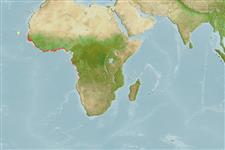>
Eupercaria/misc (Various families in series Eupercaria) >
Gerreidae (Mojarras)
Etymology: Gerres: Latin, gerres = a kind of anchovies; cited by Plinius.
More on author: Günther.
Environment: milieu / climate zone / depth range / distribution range
Ecología
marino; salobre bentopelágico; rango de profundidad ? - 60 m (Ref. 57394). Tropical; 18°N - 17°S, 29°W - 14°E
Eastern Atlantic: west African coast, from Guinea to Congo (Ref. 57394). Also reported from Senegal (Ref. 4323, 28587, 33587), Gambia (Ref. 5476), Guinea-Bissau (Ref. 26999) and as far south as Angola (Ref. 3166).
Length at first maturity / Tamaño / Peso / Age
Maturity: Lm 38.8, range 7 - ? cm
Max length : 20.0 cm TL macho / no sexado; (Ref. 57394); common length : 15.0 cm TL macho / no sexado; (Ref. 2683)
Espinas dorsales (total): 9; Radios blandos dorsales (total): 10; Espinas anales 3; Radios blandos anales: 8. Diagnosis: body oblong and compressed; snout pointed, shorter than eye diameter; mouth strongly protrusible; nostrils contiguous, situated at midpoint between eye and snout tip; dorsal fin deeply notched; pectoral fins long, reaching to, or extending beyond anal-fin origin; large cycloid scales; scales of the interocular space not reaching anterior border of eyes; spinous part of dorsal fin greyish, without a black spot at tip (Ref. 57394).
Coloration: back olivaceous-brown, sides silvery, with longitudinal dark bands; young individuals with narrow, dark vertical bars on sides; spinous part of dorsal fin distally greyish, but without a distinct black spot at tip; juveniles with 2 longitudinal series of dark spots on dorsal fin (Ref. 57394).
Occurs on littoral mud and sand bottoms to about 60 m depth (Ref. 57394). Often enters estuaries and coastal lagoons (Ref. 7375) during reproduction (Ref. 57394). Feeds on fish, shrimps, mollusks, plankton and detritus (Ref. 28587).
Life cycle and mating behavior
Madurez | Reproducción | Puesta | Huevos | Fecundidad | Larva
Roux, C., 1986. Gerridae. p. 325-326. In J. Daget, J.-P. Gosse and D.F.E. Thys van den Audenaerde (eds.) Check-list of the freshwater fishes of Africa (CLOFFA). ISNB, Brussels; MRAC, Tervuren; and ORSTOM, Paris. Vol. 2. (Ref. 4323)
IUCN Red List Status (Ref. 130435)
Threat to humans
Harmless
Human uses
Pesquerías: comercial
Más información
ReferenciasAcuiculturaPerfil de acuiculturaRazasGenéticaElectrophoresesheritabilidadEnfermedadesProcesamientoNutrientsMass conversion
ColaboradoresImágenesStamps, Coins Misc.SonidosCiguateraVelocidadTipo de nataciónSuperficie branquialOtolitosCerebrosVisión
Herramientas
Special reports
Download XML
Fuentes de Internet
Estimates based on models
Preferred temperature (Ref.
123201): 23 - 28, mean 26.5 °C (based on 78 cells).
Phylogenetic diversity index (Ref.
82804): PD
50 = 0.5000 [Uniqueness, from 0.5 = low to 2.0 = high].
Bayesian length-weight: a=0.01047 (0.00564 - 0.01943), b=3.07 (2.91 - 3.23), in cm total length, based on LWR estimates for this species & Genus-body shape (Ref.
93245).
Nivel trófico (Ref.
69278): 3.2 ±0.51 se; based on food items.
Resiliencia (Ref.
120179): Alto, población duplicada en un tiempo mínimo inferior a 15 meses (Preliminary K or Fecundity.).
Fishing Vulnerability (Ref.
59153): Low vulnerability (10 of 100).
Climate Vulnerability (Ref.
125649): High vulnerability (64 of 100).
Nutrients (Ref.
124155): Calcium = 172 [85, 323] mg/100g; Iron = 1 [1, 2] mg/100g; Protein = 18 [16, 20] %; Omega3 = 0.267 [0.132, 0.505] g/100g; Selenium = 50.4 [27.3, 98.0] μg/100g; VitaminA = 30.3 [9.0, 78.5] μg/100g; Zinc = 1.9 [1.3, 2.7] mg/100g (wet weight);
